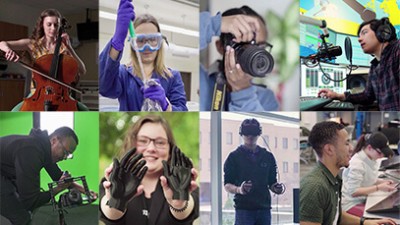CNN: Two supermassive star clouds found in Milky Way center (September 16, 1999)
This news article was originally published at 9:47 a.m. EDT on Sept. 16, 1999 on CNN.com. It is being reposted for archive purposes.
September 16, 1999
Web posted at: 9:47 a.m. EDT (1347 GMT)
By Robin Lloyd
CNN Interactive Senior Writer
(CNN) -- Glittering images of two gigantic globs of massive, young stars at the center of the Milky Way paint a new picture of how stellar clusters are born in our galaxy and others, according to research released Thursday.
Recent images of the neighboring Arches and Quintuplet clusters show that these objects are much heavier than anyone thought -- astronomers call them "supermassive" -- and are sites of extremely violent star cluster births that still take place today.
"Here we're talking about some galactic scale event that takes an already very massive cloud and just crushes it into extremely high densities forming, in one fell swoop, hundreds and hundreds of stars, most of which are far more massive than our own sun," said UCLA astronomer Mark Morris.
Weighing more than 10,000 stars like our sun, the clusters are 10 times heavier than typical clusters scattered throughout the Milky Way.
The new images of the clusters suggest that galactic centers throughout the universe may be sites where star stuff continuously bangs around and cranks out huge packs of stars, said Don Figer of the Space Telescope Science Institute in Baltimore. He worked with Morris and four other astronomers on the images.
"If you look at galactic nuclei, they are not old dead places," Figer said. The STSI oversees results from NASA's Hubble Space Telescope which snapped the cluster images.
Instead, galactic centers look like sites where molecular hydrogen laced with dust continuously zips around igniting star birth.
The results will be published in the November 10 issue of Astrophysics Journal.
Massive clusters still forming today
Astronomers have known for years that star clusters formed in the universe's early history. But before these pictures were taken, astronomers had no proof that star clusters still were forming and had no clear idea for why they collected like candy at the center of galaxies.
The latest images are the proof and the explanation, Figer said. For the first time, astronomers can see massive clusters forming today -- or close to it in astronomical time -- not billions of years ago, Figer said.
The Arches and Quintuplet clusters are 2 and 4 millions years old, respectively -- very young for a universe that's around 12 billion years old.
And galactic centers now can be seen as ideal locations for the formation of supermassive clusters, he said, where molecular clouds build up and collide, providing bursts of star formation that rip apart into clusters.
Figer first started studying star clusters as a graduate student at UCLA. For the past several years, he has tried to get sharper images to learn more.
With the latest images, he and his colleagues were able to literally count up all the stars in the Arches and Quintuplet clusters, calculate their masses and realize they are densely populated, vibrant real estate.
Some astronomers had thought that brighter stars in earlier pictures were double or triple stars, orbiting around one another and probably lighter. Instead, they are massive, single stars, Figer said. The brightest dozen stars in the cluster, including the Pistol Star, are probably the top few dozen most massive stars in the galaxy, he said.
The entire Arches cluster is so dense that three of them edge-to-edge could fit between the sun and its nearest neighbor, Figer said.
Heavy metal pollution
Astronomers discovered Arches 10 years ago -- 25,000 light years from Earth and less than 100 light years from the center of our galaxy. That cluster and its massive neighbor are two of only three such supermassive clusters in our entire galaxy.
"We didn't know we had such a good example so close by," Morris said.
Now it is clear that galactic centers, being full of star stuff, yield more massive stars. Stars are forming there frequently and dust clouds have lots of material to bang against, Figer said.
Figer's results also suggest that there will likely be more heavy elements like those on Earth -- carbon, nitrogen, oxygen and various metals -- in galactic centers, Morris said.
Massive stars there burn fast and spew out lots of "pollution," or heavier elements that are useless as stellar fuel.
But those elements are what make the universe interesting -- at least to Earthlings. Heavier elements are what you need to form planets, so it's likely that more planets form around stars in galactic centers, Morris said.
But don't go looking for life there.
"It's not a very hospitable place," he said. "It's a violent place with more cosmic explosions happening."








